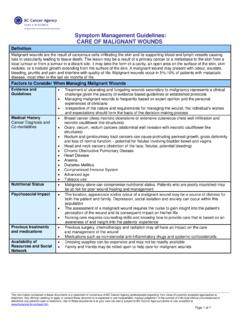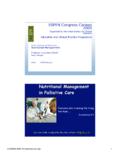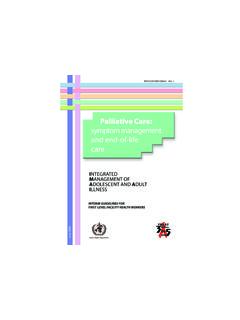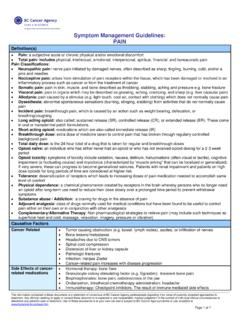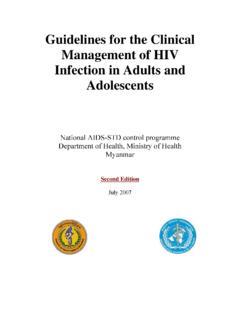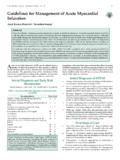Transcription of MASCC ISOO Clinical Practice Guidelines for the …
1 MASCC = isoo Clinical Practice Guidelines for the Managementof Mucositis Secondary to Cancer TherapyRajesh V. Lalla, DDS, PhD1; Joanne Bowen, PhD2; Andrei Barasch, DMD, MDSc3; Linda Elting, PhD4;Joel Epstein, DMD, MSD5; Dorothy M. Keefe, MD2; Deborah B. McGuire, PhD, RN6; Cesar Migliorati, DDS, MS, PhD7;Ourania Nicolatou-Galitis, DDS, MSc, DrDent8; Douglas E. Peterson, DMD, PhD1; Judith E. Raber-Durlacher, DDS, PhD9;Stephen T. Sonis, DMD, DMSc10; Sharon Elad, DMD, MSc11; and The Mucositis Guidelines Leadership Group of theMultinational Association of Supportive Care in Cancer and International Society of Oral Oncology ( MASCC = isoo ).BACKGROUND:Mucositis is a highly significant, and sometimes dose-limiting, toxicity of cancer therapy. The goal of this system-atic review was to update the Multinational Association of Supportive Care in Cancer and International Society of Oral Oncology( MASCC = isoo ) Clinical Practice Guidelines for :A literature search was conducted to identify eligible publishedarticles, based on predefined inclusion=exclusion criteria.
2 Each article was independently reviewed by 2 reviewers. Studies were ratedaccording to the presence of major and minor flaws as per previously published criteria. The body of evidence for each intervention,in each treatment setting, was assigned a level of evidence, based on previously published criteria. Guidelines were developed basedon the level of evidence, with 3 possible guideline determinations: recommendation, suggestion, or no guideline :The literature search identified 8279 papers, 1032 of which were retrieved for detailed evaluation based on titles and abstracts. Ofthese, 570 qualified for final inclusion in the systematic reviews. Sixteen new Guidelines were developed for or against the use of vari-ous interventions in specific treatment settings. In total, the MASCC = isoo Mucositis Guidelines now include 32 Guidelines : 22 for oralmucositis and 10 for gastrointestinal mucositis. This article describes these updated :The updatedMASCC= isoo Clinical Practice Guidelines for mucositis will help clinicians provide evidence-based management of mucositis second-ary to cancer ;120:1453 The by Wiley Periodicals, Inc.
3 On behalf of Ameri-can Cancer Society. This is an open access article under the terms of the Creative Commons Attribution-NonCommercial-NoDerivsLicens e, which permits use and distribution in any medium, provided the original work is properly cited, the use is non- commercialand no modifications or adaptations are :mucositis, stomatitis, oral, gastrointestinal, Guidelines , Multinational Association of Supportive Care in Cancer and Inter-national Society of Oral Oncology ( MASCC = isoo ).Corresponding author:Rajesh V. Lalla, DDS, PhD, University of Connecticut Health Center, 263 Farmington Ave, Farmington, CT 06030-1605; Fax: of Connecticut, Farmington, Connecticut;2 University of Adelaide, Adelaide, South Australia, Australia;3 Winthrop University Hospital, Mineola, NewYork;4 The University of Texas MD Anderson Cancer Center, Houston, Texas;5 City of Hope Medical Center, Duarte, California;6 Virginia Commonwealth University,Richmond, Virginia;7 University of Tennessee Health Science Center, Memphis, Tennessee;8 University of Athens, Athens, Greece;9 Academic Medical Center-Am-sterdam, Amsterdam, the Netherlands;10 Brigham and Women s Hospital, Boston, Massachusetts.
4 11 University of Rochester, Rochester, New YorkAdditional supporting information may be found in the online version of this members of the Mucositis Guidelines Leadership Group of the Multinational Association of Supportive Care in Cancer and International Societyof Oral On-cology ( MASCC = isoo ) are: Noor Al-Dasooqi, PhD; Michael Brennan, DDS, MHS; Rachel Gibson, PhD; Janet Fulton, PhD, RN; Ian Hewson, BDS; Siri B. Jensen, DDS,PhD; Richard Logan, BDS, MDS, PhD; Kerstin Ohrn, PhD, RDH; Triantafyllia Sarri, DDS, MSc; Deborah Saunders, DDS; Inger von B ultzingsl owen, DDS, PhD; andNoam Yarom, contributors to the Guidelines update included Justin Allemano, Abdul Rahman Al-Azri, Heliton Spindola Antunes, Anura Ariyawardana, Emma Bateman,Nicole Blijlevens, Christine B. Boers-Doets, Paolo Bossi, Carlton G. Brown, Yu-Chia Chang, Karis K. Cheng, Catherine Cooksley, Elvira P. Correa, Kristopher Dennis,Mario Di Palma, Scott Drucker, June Eilers, Carmen Escalante, Cherry L.
5 Estilo, Hele Everaus, Margot Fijlstra, Monica Fliedner, Annette Freidank, Erich Gerber, FaithGibson, Jes us Garcia Gomez, Josiah Halm, Guido Hita, Ronald D. Hutchins, Brian Hodgson, Allan Hovan, Virginia Jarvis, Emily E. King, Vassilios E. Kouloulias, MarieC. Latortue, Judith Lees, Nilza Nelly Fontana Lopes, Charles Loprinzi, Marisol Michelet, Takehiko Mori, Raj G. Nair, Pasquale Niscola, Loree K. Oberle-Edwards, An-thony Osaguona, Pratibha Parelkar, Jumin Park, Ira Parker, Bo G. Pettersson, Carin Potting, Nikhil G. Rao, Dorothea Riesenbeck, Tanya Rouleau, MarkM. Schubert,Sol Silverman Jr, Yoshihiko Soga, Fred Spijkervet, Monique Stokman, Andrea M. Stringer, Wim Tissing, Walter van der Velden, Marianne D. van deWetering, Madhuri Vithala, Dianna S. Weikel, Roger Yazbeck, Eric Yeoh, and Yehuda : The Multinational Association of Supportive Care in Cancer and International Society of Oral Oncology ( MASCC = isoo ) Mucositis Guidelines are devel-oped to facilitate the evidence-based management of mucositis.
6 However, clinicians should also use their own judgment in making treatment decisions for indi-vidual patients. The guideline authors and the MASCC = isoo do not guarantee or take responsibility for Clinical outcomes in individual Guidelines refer to the use of the listed agents for the specific indication listed (ie, the prevention or treatment of mucositis or related symptoms). Theseguidelines do not apply to the use of the listed agents for other indications. For example, although it is suggested that chlorhexidine mouthwash not be usedto prevent oral mucositis in patients receiving head and neck radiation therapy, clinicians may choose to use this agent for other indications in thisor ,Received:September 12, 2013;Revised:November 21, 2013;Accepted:December 20, 2013,Published onlineFebruary 25, 2014 inWiley Online Library ( )CancerMay 15, 20141453 Review ArticleINTRODUCTIONM ucositis refers to mucosal damage secondary to cancertherapy occurring in the oral cavity; pharyngeal, laryngeal,and esophageal regions; and other areas of the gastrointes-tinal tract.
7 Mucositis can be caused by chemotherapyand=or radiation therapy. It occurs in approximately 20%to 40% of patients receiving conventional chemotherapy,80% of patients receiving high-dose chemotherapy asconditioning for hematopoietic stem cell transplantation(HSCT), and nearly all patients receiving head and neckradiation therapy (H&NRT).1-3 Oral mucositis presentsas erythema and=or ulceration of the oral mucosa. Inaddition, the pharyngeal, laryngeal, and esophageal mu-cosa are also at risk for mucositis, particularly in patientsundergoing H&NRT. It is typically very painful, requir-ing opioid analgesics, and impairs nutritional intake andquality of ,5 Gastrointestinal mucositis presents withdebilitating symptoms such as pain, nausea=vomiting,and mucositis can necessitate a reductionin the chemotherapy dose or a treatment break in RT,which can negatively influence ,8In addition,mucositis has a considerable economic impact, due tocosts associated with symptom management , nutritionalsupport, management of secondary infection, and ,9 Thus, mucositis is a highly significant, andsometimes dose-limiting, toxicity of cancer direct cell damage from chemotherapyand=or RT initiates the process, evidence suggests that thepathogenesis of mucositis is more 5-stagemodel has been oxygen species, sec-ond messengers, proinflammatory cytokines and pathways.
8 And metabolic byproducts of colonizing microorganismsare all believed to play a role in amplifying the a result, a large number of diverse interventionshave been tested for mucositis. Although many of theseinterventions are available over the counter or for off-labeluse or marketed as devices, to the best of our knowledgeonly 1 agent to date has been approved by the US Foodand Drug Administration as a drug for mucositis, albeit ina relatively restricted population. Studies of many interven-tions range widely in quality, sometimes with conflictingresults. Therefore, there is a need for evidence-based clinicalpractice Guidelines for mucositis to guide clinicians onwhich interventions are truly 2004, the Mucositis Study Group of the Multina-tional Association of Supportive Care in Cancer and Inter-national Society of Oral Oncology ( MASCC = isoo )published what to our knowledge were the first evidence-based Clinical Practice Guidelines for ,14 Thefirst update of these Guidelines was published the last decade, other organizations have alsopublished Guidelines for mucositis.
9 The Guidelines publishedby the European Society for Medical Oncology are a directadoption of the MASCC = isoo guide-lines published by the US National Comprehensive CancerNetwork are an adaptation of the MASCC = isoo guide-lines, combined with expert , theMASCC= isoo mucositis Guidelines are the leading clinicalpractice Guidelines for this toxicity. Due to the large volumeof additional literature published since the last update, weundertook the second revision of these Guidelines , which ispresented AND METHODSOur methods and the underlying considerations havebeen described in detail in 2 recent ,19 Inbrief, we developed evidence-based Guidelines based onsystematic reviews of the evidence for various interven-tions. A research librarian constructed search strategiesand conducted literature searches through the OVID interface to Medline. Inclusion criteria were English lan-guage publications reporting testing of an intervention formucositis in humans, published in a peer-reviewed jour-nal, and indexed in Medline on or before December 31,2010.
10 We excluded articles that did not report the effectsof an intervention on mucositis or mucositis-related out-comes (such as pain), animal or in vitro studies, and litera-ture reviews. Due to the large number and diverse rangeof interventions, the reviewers and articles were organizedinto 8 Clinical sections. One section focused on gastroin-testinal mucositis and 7 sections examined the followingclasses of interventions for oral mucositis: 1) basic oralcare; 2) growth factors and cytokines; 3) antiinflammatoryagents; 4) antimicrobials, coating agents, anesthetics, andanalgesics; 5) laser and other light therapy; 6) cryotherapy;and 7) natural and miscellaneous agents. Each of the 8 sec-tions had a section head, 1 co-section heads, and 5 to10 reviewers. All participants were calibrated to ensureconsistency in the application of the review criteria. Inaddition, reviewers and section heads were provided withrole-specific written instructions and a manual detailingthe procedures.


